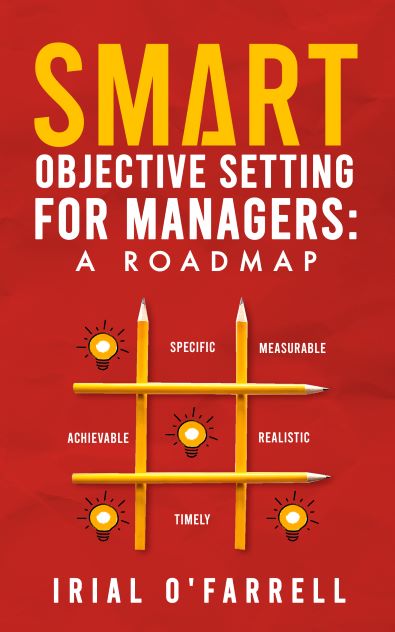 SMART Objective Setting for Managers: A Roadmap by Irial O'Farrell
SMART Objective Setting for Managers: A Roadmap by Irial O'Farrell
Objective-Setting season is fast approaching. There’s a knot in the pit of your stomach. As time ticks closer to having to set objectives with your team, you can feel the knot pulsing, getting bigger. It has to be done but what’s the point?
Unfortunately, this is how many managers feel about objective-setting. Often due to lack of training or through their negative experiences with their own manager. It often feels like a box-ticking exercise. It doesn’t have to be this way. Actively developing each team member has huge benefits, of the individual, the team, their manager, the company and clients.
SMART Objective Setting for Managers has been written specifically for managers. It sets out the relationship between job description and objectives. It deconstructs the SMART framework. It then works through practical examples of how to design objectives that will really deliver the desired outcomes. It focuses on both target-driven “what” objectives alongside behavioural “how” objectives. It also takes some time to explore both the employee’s perspective and the manager’s mindset, in relation to performance and their role.
Summaries and prompts, at the end of each chapter, recap on each chapter’s main points and allow you, the reader, to think about the points in relation to your own team. Free template downloads are also available, to help you apply the learning.
Targeted Age Group:: 18+
Heat/Violence Level: Heat Level 1 – G Rated Clean Read
What Inspired You to Write Your Book?
Having managed a team for 10+ years and having worked as an executive coach and leadership/management trainer for 20+ years, I have designed and implemented several performance management systems and trained hundreds of managers in how to implement them, including objective setting, giving effective feedback and evaluating performance. As part of this process, the same challenges, concerns and emotions come up, over and over again, regardless of industry.
In particular, managers grapple with how to design behavioural objectives such as, how to improve a person's poor communication skills, increase their self-awareness or develop their stakeholder management skills. These are difficult enough but then they have to be put into a SMART format. As a result of this, I developed a workshop, designed to help managers develop these skills. After a workshop, they could see a path forward.
When the time came to write this book, I knew this was a book that managers need.
Book Sample
CHAPTER 2: THE CATCH WITH SMART
Having looked at the relationship between Job Description and Objectives, as managers, how do we approach the process of setting objectives? Following on from Chapter 1, Jenny has identified three solid objectives for Ray to focus on for the coming period:
– Be responsible for various outputs for EMEA business units [role specific]
– Project manage SAP implementation project for the team [business-aligned]
– Enhance stakeholder management skills [behavioural development]
Jenny feels that succeeding in these three objectives will really boost both Ray’s and the team’s performance in the short-term while enhancing Ray’s career prospects in the longer-term. So, what does Jenny need to do now?
Having identified his objectives, Jenny could just leave it until she meets with Ray and discuss the objectives with him then. However, as we will see, Jenny’s understanding of what each of these objectives means and how they will be evaluated might be the same as Ray’s understanding or, much more likely, could be wildly different. Enter the SMART model, which, as we saw in the Introduction, stands for:
S Specific
M Measurable
A Attainable
R Relevant*
T Timeframe
*Some people use the word Realistic rather than Relevant. As Realistic is very closely aligned with Attainable, I prefer to use Relevant to allow for a link between the objective and why it matters.
Using SMART has long been accepted as the most effective way for setting out objectives. However, many managers dislike SMART, so much so that I usually expect a groan or two when I mention the acronym. What I have noticed is that many managers struggle to use SMART in any useful way, particularly when it comes to behavioural, how objectives. I find that once they’ve gone through my SMART Objective Setting workshop, they are much clearer on how to use it, both with the WHAT and the HOW objectives, and are much more positive about using SMART.
At the start of the workshop, having checked that participants know what SMART stands for, and regardless of my audience, I ask the group if the following objective is SMART:
“I’m going out, can you do the dishes?”
The conversation usually runs something like this:
Them: No, there’s no timeframe.
Me: Okay then, I’ll rephrase: I’m going out; I’ll be back in an hour. Can you have the dishes done?
Them: Yeah, that’s SMART.
Me: Is it?
Them: Eh, yeah, it’s SMART. You have the specific and the measurable and the timeframe. The relevant and attainable are both fine.
Me: So, is it SMART?
Them: Yes.
Me: You’re sure?
Them: Yep, we’re sure.
Me: Okay, so hands up; whose idea of doing the dishes is “washing the dishes and letting them drip-dry on the counter”?
The bigger the group, the more likely you are to get a couple of people putting their hands up.
Me: So, whose idea of doing the dishes is “washing the dishes and drying them”?
Usually, a few hands go up.
Me: Whose idea of doing the dishes is “washing and drying them and putting them away”?
The majority of hands go up for this one, often along with one or two hands from the previous group with “Oh, that’s what I meant” or “Oh, that’s what I thought you meant” type comments.
Me: Whose idea is “washing, drying and putting away the dishes and wiping down the counters”?
Usually, the rest of the hands go up on this one, with everyone else in the room feeling like they’ve been shamed by their lack of cleaning prowess. This one is often accompanied by some knowing laughs, as they now understand why they constantly end up in arguments at home about the dishes being “done”.
In one session, one person didn’t put up their hand so I asked them why, to which they replied, “Oh, my idea of doing the dishes is all of the above and sweeping the floors.” Upon recovering from my chastisement, I added this option into workshops and, yes, occasionally it does get selected.
One of my all-time favourite responses to this exercise was an exclamation of, “Oh, you want the kitchen cleaned.” We all fell around the place laughing at the implied nuanced difference between the phrases “doing the dishes” and “cleaning the kitchen”. To this person, there was clearly a difference. To the rest of us, they were two ways of saying the same thing.
Once the laughing has settled down, I highlight that SMART can be very effective in setting out and framing an objective. However, a natural constraint exists when using SMART between two people. So, care needs to be taken in clearly constructing an objective and ensuring a common understanding between both parties. Otherwise, issues will arise due to differences in expectations. If someone initially selected the second dishes option and then changed it to the third option, I highlight the point that, if the manager isn’t clear on what is expected, how can the employee be clear?
I use this example because, regardless of level, everyone can understand and relate to it and it beautifully highlights that, for such a simple task, there are five or six different ways it can be interpreted while looking like a SMART objective.
Links to Purchase Print Book version – Click links for book samples, reviews and to purchase
Buy SMART Objective Setting for Managers: A Roadmap Print Edition at Amazon
Buy SMART Objective Setting for Managers: A Roadmap at Barnes and Noble
Links to Purchase eBook version – Click links for book samples, reviews and to purchase
Buy this eBook On Amazon
Buy this eBook on Barnes and Noble for Nook
Buy this eBook on iBooks
Buy this eBook on Kobo
Buy this eBook on Smashwords
About the Author
Please join this author’s email list
For joining the author’s email/newsletter list you will get:
Free templates including: Objective Setting Meeting Preparation Template; Performance Issues Driver Analysis Template
Learn more about the author on their website
Follow the author on Amazon
Follow the author on Social Media:
Facebook
Twitter
Goodreads
Instagram
LinkedIn
YouTube Channel
All information was provided by the author and not edited by us. This is so you get to know the author better.









